Effect of Superabsorbent Polymers and Presoaked Coarse Recycled Shale Lightweight Aggregates on Relative Humidity Development in Early-Age Concrete
Abstract
:1. Introduction
2. Materials and Methods
2.1. Materials
2.2. Mixture Proportions
2.3. Sensor Calibration
2.4. Concrete Mixing and Experimental Procedures
3. Results and Discussion
3.1. Setting Time
3.2. Effect of SAP on the Development of the RH
3.3. Effect of RSLA on the Development of the RH and Autogenous Shrinkage
3.4. Synergistic Effect of RSLA and SAP on the Development of RH
4. Conclusions
- SAP and RSLA have a substantial effect on the setting. With increasing dosages of SAP and RSLA, a significant delay in the initial and final setting times can be observed. Moreover, the extent of the delay is less influenced by the proportion of SAP and RSLA but depends on the IC water quantity. The initial setting time of RSLA30 and SAP06 is delayed by 127 and 171 min, respectively, compared to the benchmark mixture.
- SAP and RSLA have a great influence on the RH development of early-age concrete. Specifically, the addition of both can significantly extend the duration of the vapour-saturated stage in a hydration process and increase the RH level at 28 days after casting. When the RSLA dosage increases from 0 to 10%, 20%, and 30%, the duration of the vapour-saturated stage is extended by 2, 9.4, and 26 days, respectively. Furthermore, both substances are effective in alleviating the early-age shrinkage based on the reduction in capillary stress caused by the decrease in RH, which benefits mitigating cracking at an early age.
- SAP and RSLA interact with each other and change each other’s desorption behaviour. Because most IC water is released by RSLA in a preliminary stage, the RH gradient near IC agents decreases, which leads to a decline in water desorption until more water is consumed with hydration. Hence, a substantial increase in RH at 28 days can be observed in the mixture of SAP and presoaked RSLA.
Author Contributions
Funding
Data Availability Statement
Conflicts of Interest
References
- Zhao, H.; Ding, J.; Huang, Y.; Tang, Y.; Xu, W.; Huang, D. Experimental analysis on the relationship between pore structure and capillary water absorption characteristics of cement-based materials. Struct. Concr. 2019, 20, 1750–1762. [Google Scholar] [CrossRef]
- Hou, D.; Zhao, T.; Ma, H.; Li, Z. Reactive molecular simulation on water confined in the nanopores of the calcium silicate hydrate gel: Structure, reactivity, and mechanical properties. J. Phys. Chem. C 2015, 119, 1346–1358. [Google Scholar] [CrossRef]
- Chen, S.; Zhao, H.; Chen, Y.; Huang, D.; Chen, Y.; Chen, X. Experimental study on interior relative humidity development in early-age concrete mixed with shrinkage-reducing and expansive admixtures. Constr. Build. Mater. 2020, 232, 117204. [Google Scholar] [CrossRef]
- Liu, J.; Shi, C.; Ma, X.; Khayat, K.H.; Zhang, J.; Wang, D. An overview on the effect of internal curing on shrinkage of high performance cement-based materials. Constr. Build. Mater. 2017, 146, 702–712. [Google Scholar] [CrossRef]
- Mechtcherine, V.; Gorges, M.; Schroefl, C.; Assmann, A.; Brameshuber, W.; Ribeiro, A.B.; Cusson, D.; Custódio, J.; da Silva, E.F.; Ichimiya, K.; et al. Effect of internal curing by using superabsorbent polymers (SAP) on autogenous shrinkage and other properties of a high-performance fine-grained concrete: Results of a RILEM round-robin test. Mater. Struct. 2014, 47, 541–562. [Google Scholar] [CrossRef]
- Khatib, J.M. Properties of concrete incorporating fine recycled aggregate. Cem. Concr. Res. 2005, 35, 763–769. [Google Scholar] [CrossRef]
- Li, Y.; Zhang, H.; Zhang, Z.; Li, Y.; Fang, H.; Yuan, J.; Tang, S. The early-age cracking sensitivity, shrinkage, hydration process, pore structure and micromechanics of cement-based materials containing alkalis with different metal ions. Dev. Built Environ. 2024, 18, 100454. [Google Scholar] [CrossRef]
- Wang, L.; Li, G.; Li, X.; Guo, F.; Tang, S.; Lu, X.; Hanif, A. Influence of reactivity and dosage of MgO expansive agent on shrinkage and crack resistance of face slab concrete. Cem. Concr. Compos. 2022, 126, 104333. [Google Scholar] [CrossRef]
- Wang, L.; Yu, Z.; Liu, B.; Zhao, F.; Tang, S.; Jin, M. Effects of fly ash dosage on shrinkage, crack resistance and fractal characteristics of face slab concrete. Fractal Fract. 2022, 6, 335. [Google Scholar] [CrossRef]
- Voigt, T.; Ye, G.; Sun, Z.; Shah, S.P.; van Breugel, K. Early age microstructure of Portland cement mortar investigated by ultrasonic shear waves and numerical simulation. Cem. Concr. Res. 2005, 35, 858–866. [Google Scholar] [CrossRef]
- Jun, Z.; Dongwei, H.; Haoyu, C. Experimental and theoretical studies on autogenous shrinkage of concrete at early ages. J. Mater. Civ. Eng. 2011, 23, 312–320. [Google Scholar] [CrossRef]
- C1157/C1157M-17; Standard Performance Specification for Hydraulic Cement. ASTM: West Conshohocken, PA, USA, 2017.
- Jensen, O.M.; Hansen, P.F. Water-entrained cement-based materials: II. Experimental observations. Cem. Concr. Res. 2002, 32, 973–978. [Google Scholar] [CrossRef]
- JLamond, F.; Campbell, R.L.; Campbell, J.A.; Giraldi, A.; Halczak, W.; Hale, H.C.; Jenkins, N.J.T.; Miller, R.; Seabrook, P.T. Removal and reuse of hardened concrete: Reported by ACI committee 555. ACI Mater. J. 2002, 99, 300–325. [Google Scholar]
- C1761/C1761M-17; Standard Specification for Lightweight Aggregate for Internal Curing of Concrete. ASTM: West Conshohocken, PA, USA, 2017.
- Zhao, H.; Ding, J.; Li, S.; Wang, P.; Chen, Y.; Liu, Y.; Tian, Q. Effects of porous shale waste brick lightweight aggregate on mechanical properties and autogenous deformation of early-age concrete. Constr. Build. Mater. 2020, 261, 120450. [Google Scholar] [CrossRef]
- Powers, T.C.; Brownyard, T.L. Studies of the physical properties of hardened Portland cement paste. J. Am. Concr. Inst. Proc. 1946, 43, 469–504. [Google Scholar]
- Bentz, D.P.; Snyder, K.A. Protected paste volume in concrete: Extension to internal curing using saturated lightweight fine aggregate. Cem. Concr. Res. 1999, 29, 1863–1867. [Google Scholar] [CrossRef]
- Jensen, O.M.; Hansen, P.F. Water-entrained cement-based materials: I. Principles and theoretical background. Cem. Concr. Res. 2001, 31, 647–654. [Google Scholar] [CrossRef]
- E104-02(2012); Standard Practice for Maintaining Constant Relative Humidity by Means Of Aqueous Solutions. ASTM: West Conshohocken, PA, USA, 2002.
- C143/C143M-15a; Test Method for Hydraulic-Cement Concrete. ASTM: West Conshohocken, PA, USA, 2015.
- Liu, J.; Tian, Q.; Wang, Y.; Li, H.; Xu, W. Evaluation Method and Mitigation Strategies for Shrinkage Cracking of Modern Concrete. Engineering 2021, 7, 348–357. [Google Scholar] [CrossRef]
- C807-18; Standard Test Method for Time of Setting of Hydraulic Cement Mortar by Modified Vicat Needle. ASTM: West Conshohocken, PA, USA, 2018.
- Zhao, H.; Jiang, K.; Hong, B.; Yang, R.; Xu, W.; Tian, Q.; Liu, J. Experimental and Numerical Analysis on Coupled Hygro-Thermo-Chemo-Mechanical Effect in Early-Age Concrete. J. Mater. Civ. Eng. 2021, 33, 04021064. [Google Scholar] [CrossRef]
- Cusson, D.; Hoogeveen, T. Internal curing of high-performance concrete with pre-soaked fine lightweight aggregate for prevention of autogenous shrinkage cracking. Cem. Concr. Res. 2008, 38, 757–765. [Google Scholar] [CrossRef]
- Shen, P.; Lu, L.; Wang, F.; He, Y.; Hu, S.; Lu, J.; Zheng, H. Water desorption characteristics of saturated lightweight fine aggregate in ultra-high performance concrete. Cem. Concr. Compos. 2020, 106, 103456. [Google Scholar] [CrossRef]
- Justs, J.; Wyrzykowski, M.; Bajare, D.; Lura, P. Internal curing by superabsorbent polymers in ultra-high performance concrete. Cem. Concr. Res. 2015, 76, 82–90. [Google Scholar] [CrossRef]
- Han, Y.; Zhang, J.; Luosun, Y.; Hao, T. Effect of internal curing on internal relative humidity and shrinkage of high strength concrete slabs. Constr. Build. Mater. 2014, 61, 41–49. [Google Scholar] [CrossRef]
- Němeček, J.; Králík, V.; Vondřejc, J. Micromechanical analysis of heterogeneous structural materials. Cem. Concr. Compos. 2013, 36, 85–92. [Google Scholar] [CrossRef]
- Darquennes, A.; Staquet, S.; Delplancke-Ogletree, M.-P.; Espion, B. Effect of autogenous deformation on the cracking risk of slag cement concretes. Cem. Concr. Compos. 2011, 33, 368–379. [Google Scholar] [CrossRef]
- Cusson, D. Effect of blended cements on effectiveness of internal curing of HPC. In ACI SP-256, Internal Curing of High-Performance Concretes: Laboratory and Field Experiences; American Concrete Institute: Farmington Hills, MI, USA, 2008; pp. 105–120. [Google Scholar]
- Lee, K.; Lee, H.; Lee, S.; Kim, G. Autogenous shrinkage of concrete containing granulated blast-furnace slag. Cem. Concr. Res. 2006, 36, 1279–1285. [Google Scholar] [CrossRef]
- Lura, P. Autogenous Deformation and Internal Curing of Concrete. Ph.D. Thesis, Delft University, Delft, The Netherlands, 2003. [Google Scholar]
- Tazawa, E. Technical committee report on Autogenous shrinkage. Proc. JCI 1996, 18, 29–38. [Google Scholar]
- Baroghel-Bouny, V.; Mainguy, M.; Lassabatere, T.; Coussy, O. Characterization and identification of equilibrium and transfer moisture properties for ordinary and high-performance cementitious materials. Cem. Concr. Res. 1999, 29, 1225–1238. [Google Scholar] [CrossRef]
- Mohr, B.; Hood, K. Influence of bleed water reabsorption on cement paste autogenous deformation. Cem. Concr. Res. 2010, 40, 220–225. [Google Scholar] [CrossRef]
- Bentz, D.P.; Stutzman, P.E. Evolution of porosity and calcium hydroxide in laboratory concretes containing silica fume. Cem. Concr. Res. 1994, 24, 1044–1050. [Google Scholar] [CrossRef]
- Grasley, Z.C.; Lange, D.A.; D’Ambrosia, M.D. Internal relative humidity and drying stress gradients in concrete. Mater. Struct. 2006, 39, 901–909. [Google Scholar] [CrossRef]
- Zhang, J.; Hou, D.; Han, Y. Micromechanical modeling on autogenous and drying shrinkages of concrete. Constr. Build. Mater. 2012, 29, 230–240. [Google Scholar] [CrossRef]
- Wittmann, F. Interaction of hardened cement paste and water. J. Am. Ceram. Soc. 1973, 56, 409–415. [Google Scholar] [CrossRef]
- Bažant, Z. Thermodynamics of hindered adsorption and its implications for hardened cement paste and concrete. Cem. Concr. Res. 1972, 2, 1–16. [Google Scholar] [CrossRef]
- Wang, F.; Yang, J.; Cheng, H.; Wu, J.; Liang, X. Study on Mechanism of Desorption Behavior of Saturated Superabsorbent Polymers in Concrete. ACI Mater. J. 2015, 112, 463–469. [Google Scholar] [CrossRef]
- Kong, X.-M.; Zhang, Z.-L.; Lu, Z.-C. Effect of pre-soaked superabsorbent polymer on shrinkage of high-strength concrete. Mater. Struct. 2015, 48, 2741–2758. [Google Scholar] [CrossRef]
- Zhang, J.; Huang, Y.; Qi, K.; Gao, Y. Interior Relative Humidity of Normal- and High-Strength Concrete at Early Age. J. Mater. Civ. Eng. 2012, 24, 615–622. [Google Scholar] [CrossRef]
- Zhang, L.; Qian, X.; Yu, C.; Fang, M.; Qian, K.; Lai, J. Influence of evaporation rate on pore size distribution, water loss, and early-age drying shrinkage of cement paste after the initial setting. Constr. Build. Mater. 2019, 226, 299–306. [Google Scholar] [CrossRef]
- Wang, F.; Yang, J.; Hu, S.; Li, X.; Cheng, H. Influence of superabsorbent polymers on the surrounding cement paste. Cem. Concr. Res. 2016, 81, 112–121. [Google Scholar] [CrossRef]


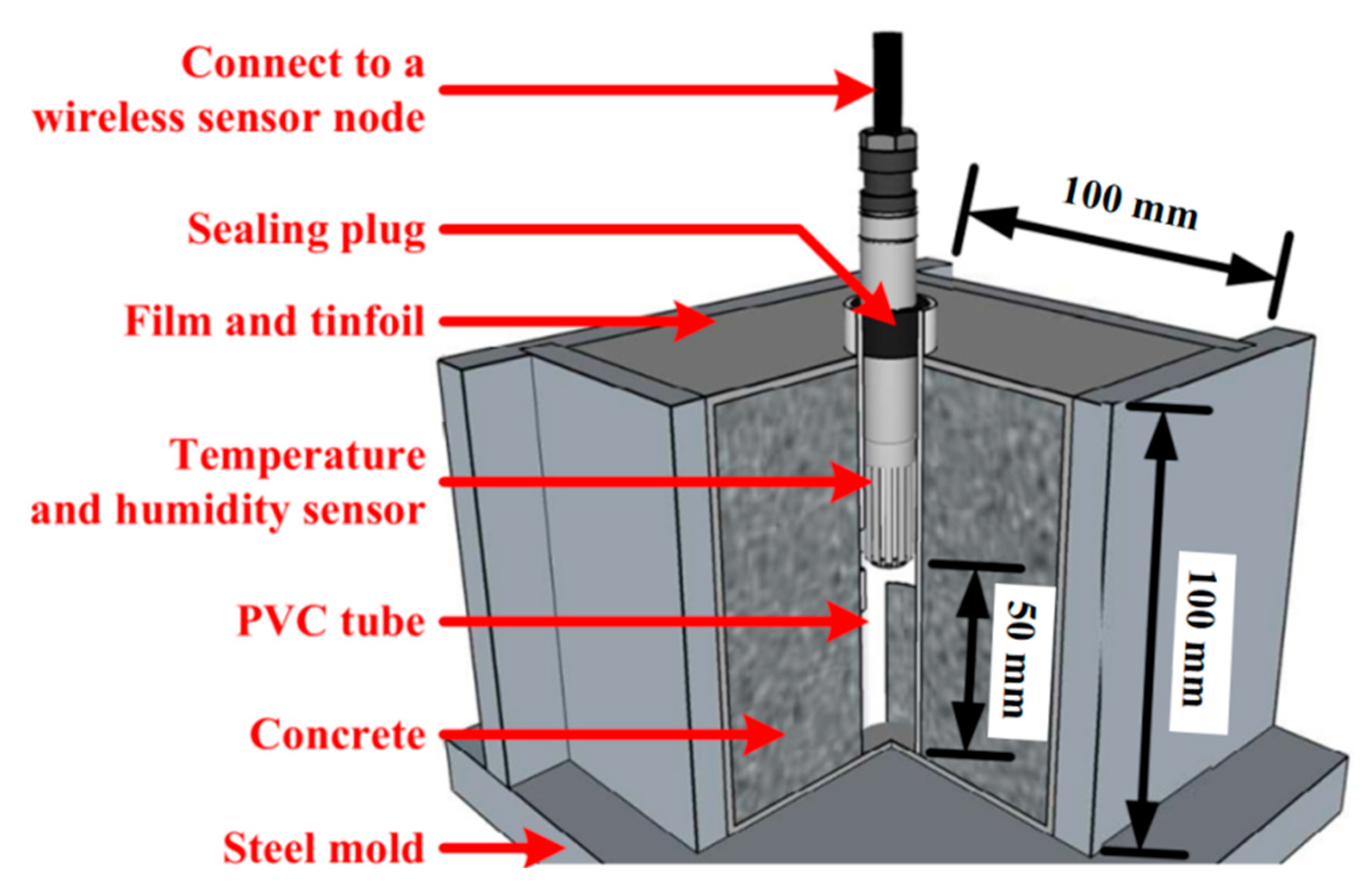
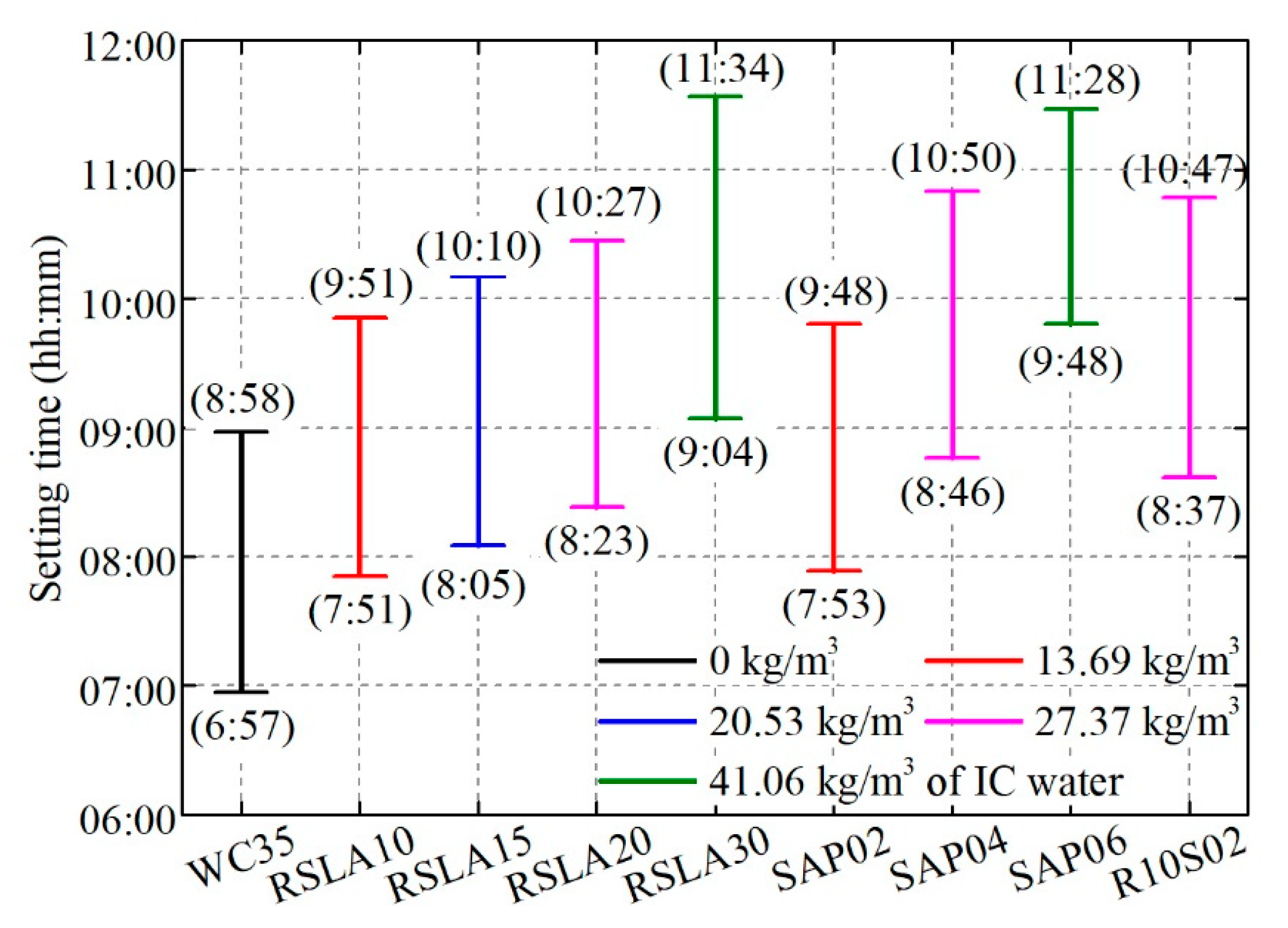


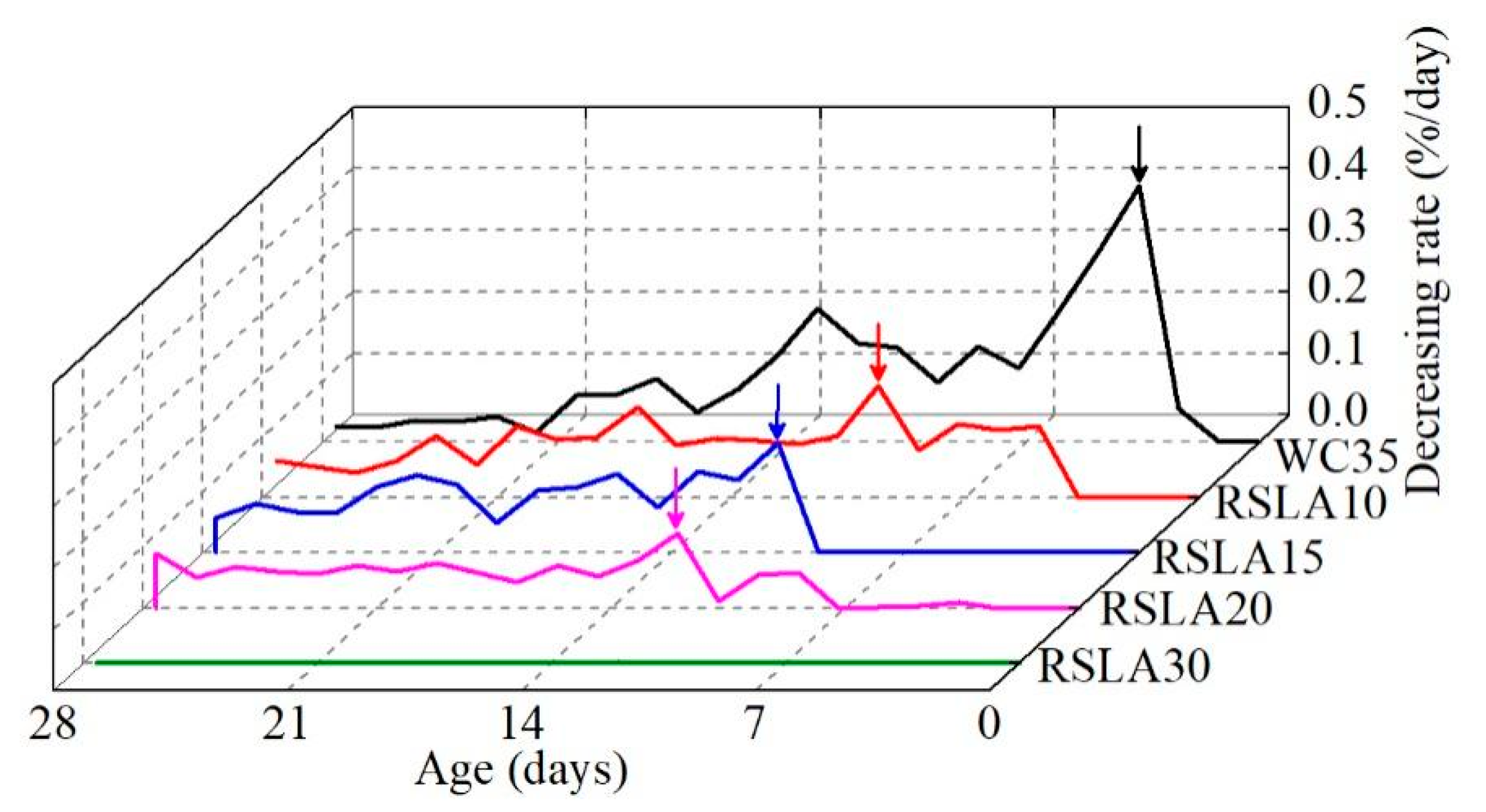
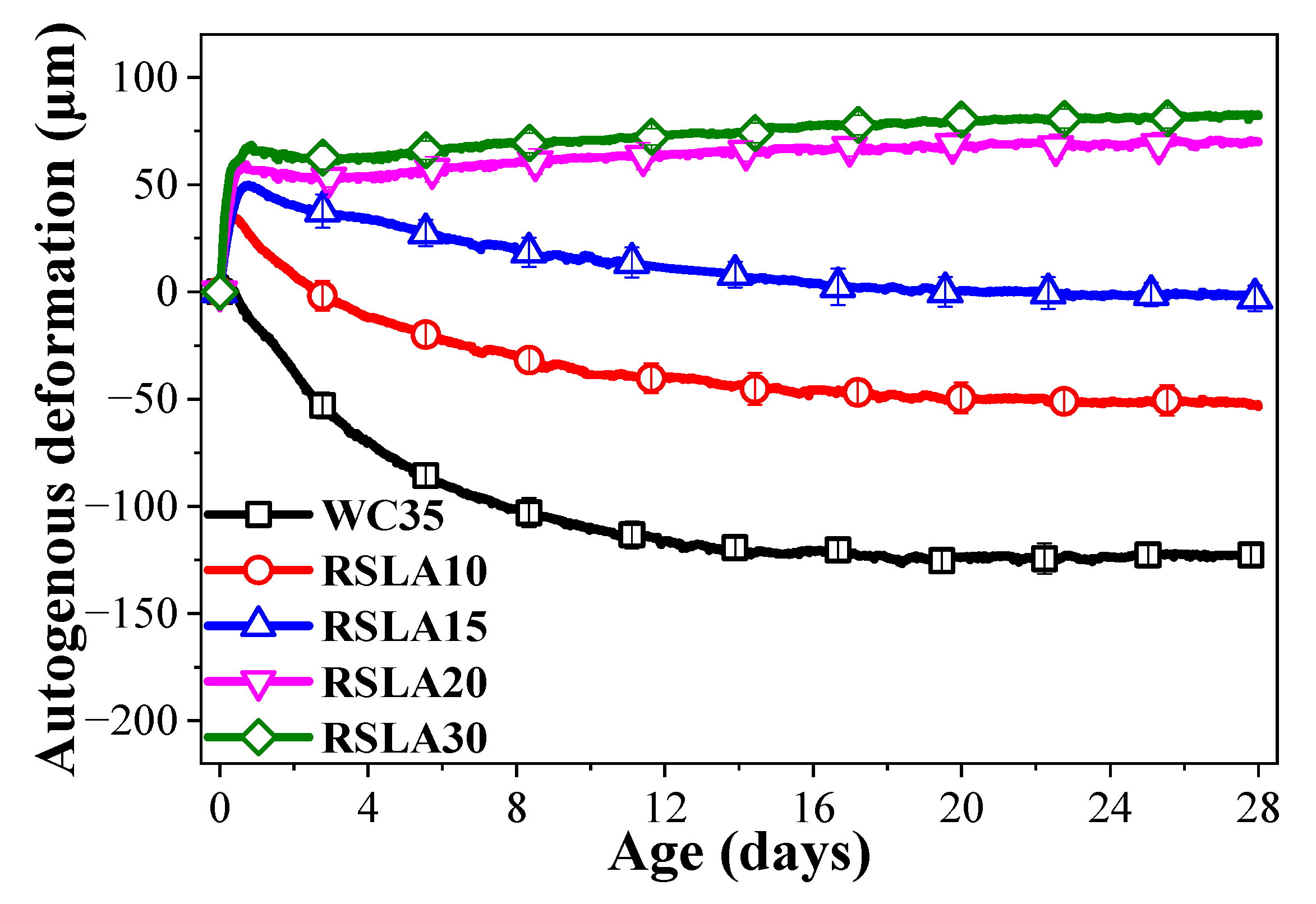
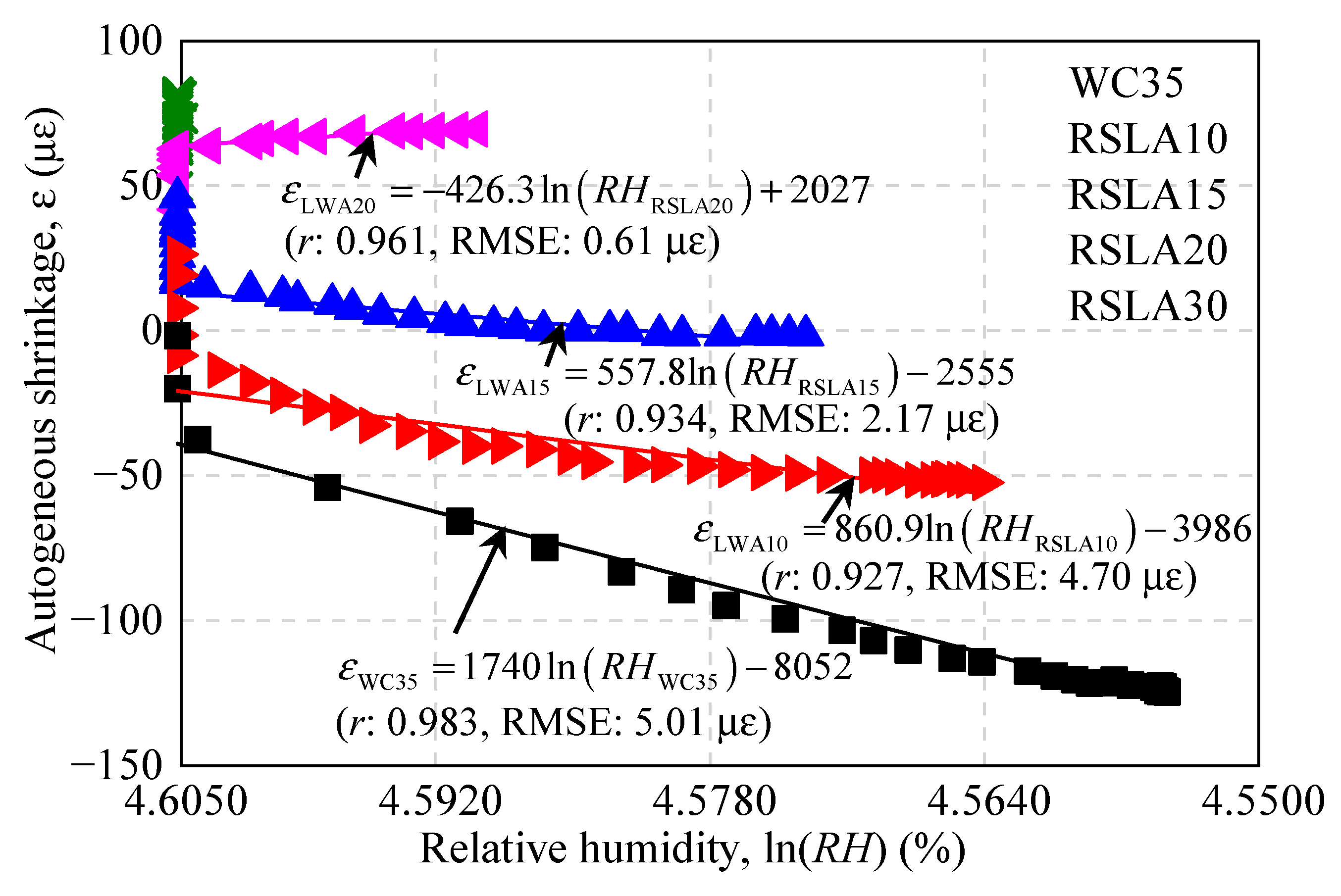

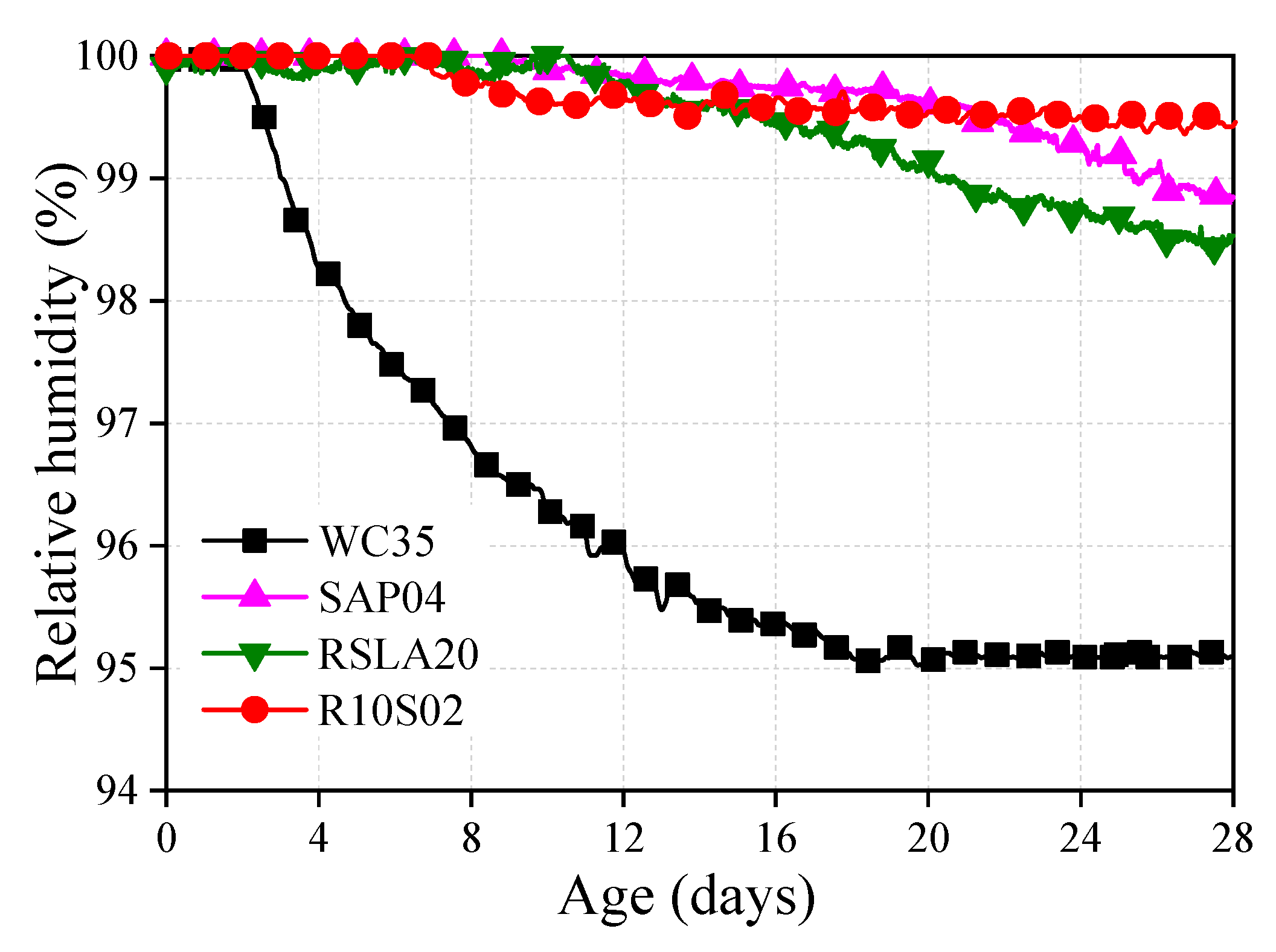
| Chemical Composition | SiO2 | Al2O3 | Fe2O3 | CaO | MgO | Na2O | K2O | SO3 | TiO2 | Loss on Ignition |
|---|---|---|---|---|---|---|---|---|---|---|
| Ordinary Portland cement (unit: %) | 19.53 | 4.31 | 2.89 | 63.84 | 1.25 | 0.13 | 0.64 | 3.25 | 0.26 | 3.04 |
| Mixture ID | WC 35 | RSLA10 | RSLA15 | RSLA20 | RSLA30 | SAP 02 | SAP 04 | SAP 06 | R10S02 | |
|---|---|---|---|---|---|---|---|---|---|---|
| w/c | 0.35 | 0.35 | 0.35 | 0.35 | 0.35 | 0.35 | 0.35 | 0.35 | 0.35 | |
| Mass fraction of RSLA (%) | 0 | 10 | 15 | 20 | 30 | 0 | 0 | 0 | 10 | |
| Mass fraction of SAP (%) | 0 | 0 | 0 | 0 | 0 | 0.2 | 0.40 | 0.60 | 0.20 | |
| Mass in per 1 m3 of concrete (kg) | Water | 168 | 168 | 168 | 168 | 168 | 168 | 168 | 168 | 168 |
| Cement | 480 | 480 | 480 | 480 | 480 | 480 | 480 | 480 | 480 | |
| Sand | 613 | 613 | 613 | 613 | 613 | 613 | 613 | 613 | 613 | |
| Gravel | 1139 | 1025 | 968 | 911 | 797 | 1139 | 1139 | 1139 | 1025 | |
| RSLA | 0 | 88.3 | 132.4 | 176.6 | 264.9 | 0 | 0 | 0 | 88.3 | |
| SAP | 0 | 0 | 0 | 0 | 0 | 0.95 | 1.89 | 2.85 | 0.95 | |
| IC water | 0 | 13.69 | 20.53 | 27.37 | 41.06 | 13.69 | 27.37 | 41.06 | 27.37 | |
Disclaimer/Publisher’s Note: The statements, opinions and data contained in all publications are solely those of the individual author(s) and contributor(s) and not of MDPI and/or the editor(s). MDPI and/or the editor(s) disclaim responsibility for any injury to people or property resulting from any ideas, methods, instructions or products referred to in the content. |
© 2024 by the authors. Licensee MDPI, Basel, Switzerland. This article is an open access article distributed under the terms and conditions of the Creative Commons Attribution (CC BY) license (https://creativecommons.org/licenses/by/4.0/).
Share and Cite
Hu, N.; Hu, D.; Ben, S.; Chen, S.; Zhao, H. Effect of Superabsorbent Polymers and Presoaked Coarse Recycled Shale Lightweight Aggregates on Relative Humidity Development in Early-Age Concrete. Buildings 2024, 14, 2159. https://doi.org/10.3390/buildings14072159
Hu N, Hu D, Ben S, Chen S, Zhao H. Effect of Superabsorbent Polymers and Presoaked Coarse Recycled Shale Lightweight Aggregates on Relative Humidity Development in Early-Age Concrete. Buildings. 2024; 14(7):2159. https://doi.org/10.3390/buildings14072159
Chicago/Turabian StyleHu, Nan, Dongkang Hu, Shujun Ben, Shuo Chen, and Haitao Zhao. 2024. "Effect of Superabsorbent Polymers and Presoaked Coarse Recycled Shale Lightweight Aggregates on Relative Humidity Development in Early-Age Concrete" Buildings 14, no. 7: 2159. https://doi.org/10.3390/buildings14072159





